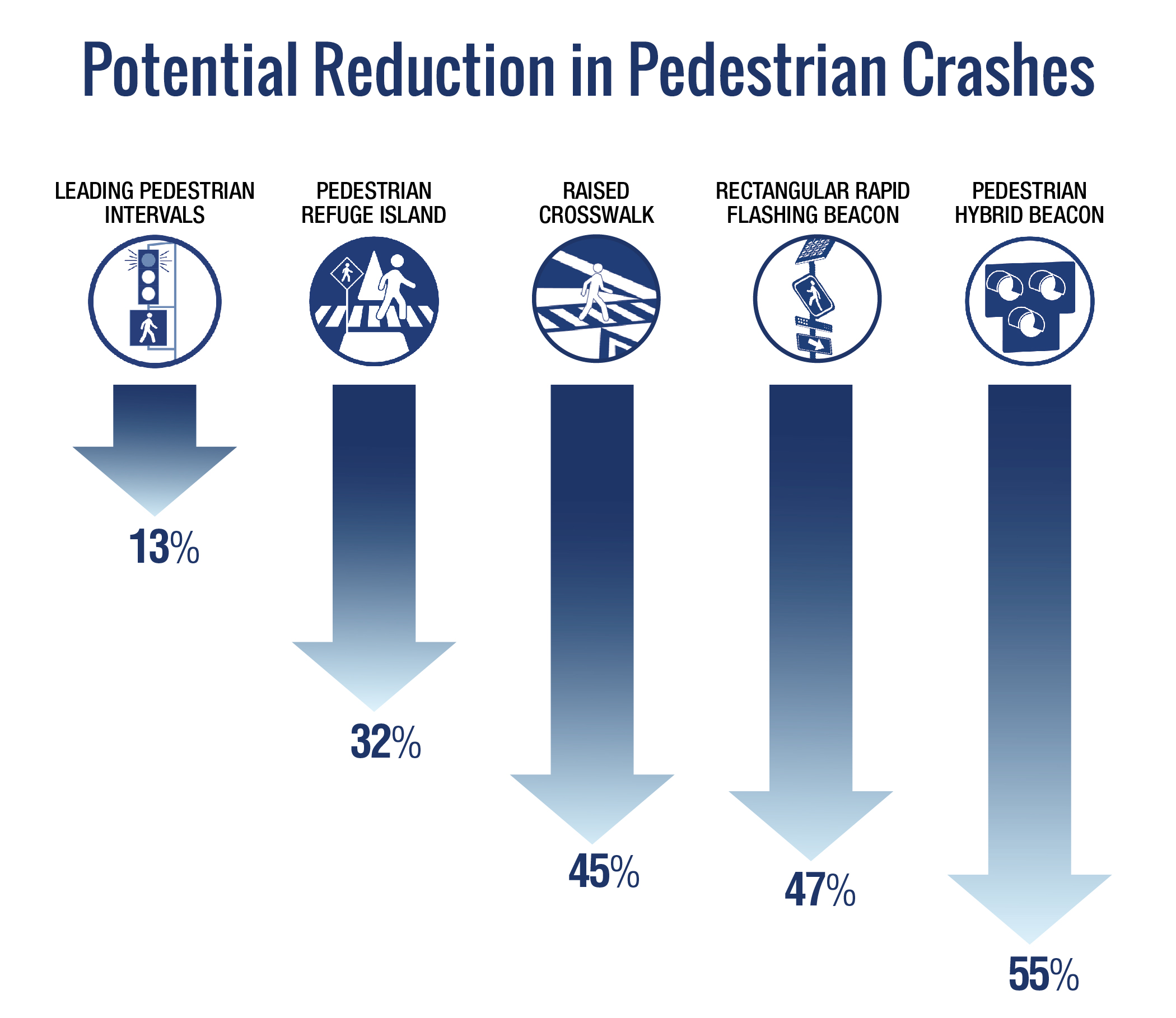Pedestrian fatalities escalated 53 percent between 2009 and 2018, according to the National Highway Traffic Safety Administration. Crashes with vehicles killed 6,283 pedestrians in 2018, the highest number since 1990.
To help address this national safety problem, the Every Day Counts (EDC) initiative on safe transportation for every pedestrian (STEP) is promoting proven safety countermeasures for pedestrian crossings. In EDC round five (EDC-5), 34 States set goals to advance implementation of some or all of what the STEP team calls the “spectacular seven” countermeasures. By early 2020, 12 States have advanced or met their EDC-5 goal. Seven States have institutionalized the use of STEP countermeasures.
The STEP team has helped more than 20 states develop STEP action plans. “State officials creating action plans meet to identify opportunities for strengthening policy and project-level decisions to incorporate the STEP countermeasures,” said Becky Crowe, Federal Highway Administration transportation specialist and team co-leader. “The STEP team provides each State with a report summarizing the strategies discussed at the meeting for near-term implementation.”
For States implementing STEP plans, the team supplies enhanced training and on-the-ground assistance. Upcoming workshops will deliver STEP training to metropolitan planning organizations, with case studies applicable to local governments. The team also helps State and local agencies conduct pedestrian safety-focused road safety audits, in which multidisciplinary teams identify opportunities to apply STEP countermeasures on corridors or sites.
The team will lead scan tours this year with transportation officials to see successful STEP countermeasure installations and discuss innovations to improve pedestrian safety. “Scan tour participants will consider how the STEP countermeasures can work in various contexts—including urban areas, suburban corridors, and tourist destinations,” said Crowe.
STEP promotes cost-effective countermeasures to help pedestrians cross the road safely:
- Rectangular rapid flashing beacons are amber lights that use an irregular flash pattern at midblock or uncontrolled crossing locations.
- Crosswalk visibility enhancements include crosswalk lighting, enhanced signing and marking, and curb extensions.
- Raised crosswalks are a traffic-calming technique that can reduce vehicle speeds and encourage drivers to yield to pedestrians.
- Pedestrian refuge islands provide a safe place for pedestrians to stop at the midpoint of a road before crossing the remaining distance.
- Pedestrian hybrid beacons offer stop control for higher speed multilane roads where pedestrian volumes are not high enough to warrant traffic signals.
- Road diets reconfigure a road cross-section to safely accommodate all users, reducing the number of lanes pedestrians must cross and creating space for new pedestrian facilities.
- Leading pedestrian intervals at signalized intersections allow pedestrians to walk several seconds before vehicles get a green signal
to turn.
 Photo Credit: FHWA
Photo Credit: FHWATransportation departments that integrate STEP into plans, policies, and programs provide models other agencies can adapt to their own needs. An example is the Washington State Department of Transportation Design Manual, which provides guidance on designing a highway system that meets multimodal needs and provides engineers with tools to design safer pedestrian crossings. The manual includes guidance on safety strategies such as target speeds for vehicles and the installation of marked crosswalks at uncontrolled intersections and midblock locations.
The Connecticut Department of Transportation (CTDOT) adopted a programmatic approach to address pedestrian safety, including policy, planning, and engineering and design. Pedestrian safety is embedded in Connecticut’s Complete Streets policy, Active Transportation Plan, and Highway Safety Plan. CTDOT developed countermeasure guidance based on FHWA’s Guide for Improving Pedestrian Safety at Uncontrolled Crossing Locations.
The New Jersey Department of Transportation’s Complete Streets Design Guide includes a toolbox of pedestrian safety improvements tailored to meet multimodal needs. The guide draws on best practices from national design guides, emphasizes context and flexibility in the design process, and describes the benefits and applications of design options. It provides recommendations on STEP countermeasures, including visibility enhancements, refuge islands, and raised crosswalks.
The Georgia Department of Transportation updated its Pedestrian and Streetscape Guide to better integrate pedestrian safety into street design, specifically highlighting the STEP countermeasures. The guide’s midblock pedestrian crossing evaluation process helps engineers and planners consider crosswalk placement and additional safety countermeasures. The crossing evaluation provides screening questions to help decision makers collect relevant data.
—MORE INFORMATION
View an Innovation Spotlight video on pedestrian countermeasures that focus on
crossing locations.
See the STEP playlist for videos that explain the benefits of road diets,
pedestrian hybrid beacons, raised crosswalks, pedestrian refuge islands, and crosswalk visibility enhancements.
Visit the STEP web page for resources, webinars, and videos to aid STEP deployment.
Contact Becky Crowe of the FHWA Office of Safety or Peter Eun of the FHWA Resource Center for information and technical assistance.
crossing locations.
